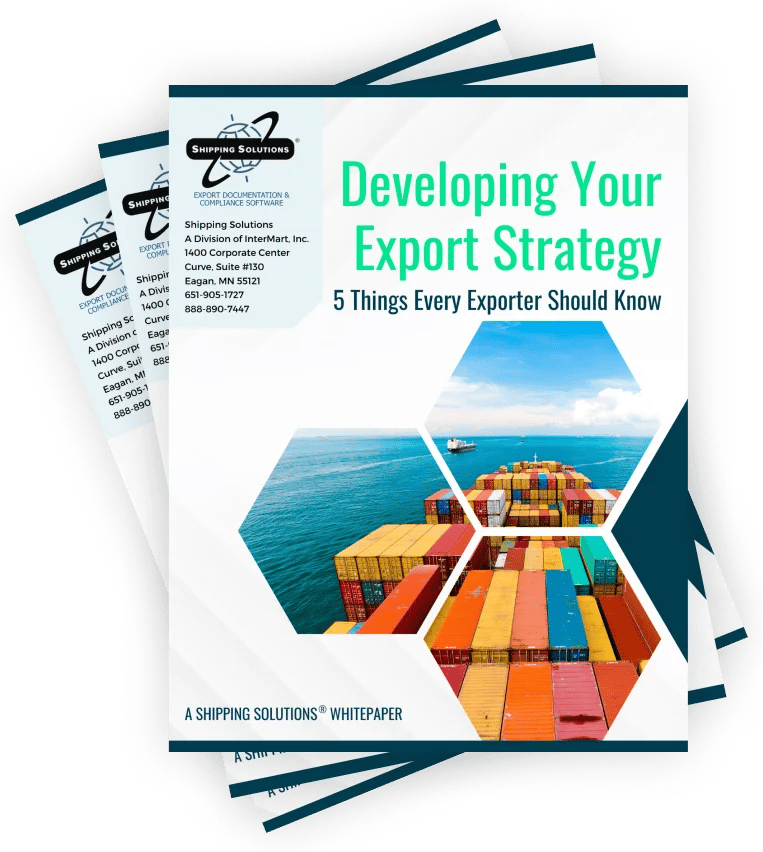The International Trade Blog International Sales & Marketing
6 Steps for Building a Successful Export Strategy
On: February 2, 2022 | By:  David Noah |
6 min. read
David Noah |
6 min. read
 When I began Shipping Solutions, I didn’t have an in-depth, strategic plan of how the business would work. I simply dove in. Like many risks taken in life, sometimes you just have to do it and figure it out along the way. For me, it wasn’t a bad way to start a business. Because I didn’t know what I didn’t know, I wasn’t intimidated by all the challenges I would face.
When I began Shipping Solutions, I didn’t have an in-depth, strategic plan of how the business would work. I simply dove in. Like many risks taken in life, sometimes you just have to do it and figure it out along the way. For me, it wasn’t a bad way to start a business. Because I didn’t know what I didn’t know, I wasn’t intimidated by all the challenges I would face.
That being said, there came a point fairly early in the life of my company when I realized I had to stop being reactive and start becoming more strategic. I signed up for evening classes at a local university on being an entrepreneur and creating a forward-looking business plan. (The class was so good, I actually signed up a second time a few years later.) These classes guided my planning and focused my research to help me build a company that continues to grow more than 30 years later.
The same thing can be true for exporting. During the past 30 years I have talked to many people at a variety of different companies who just dove in and started to export their goods and services. In some cases, they made a conscious decision to begin exporting; more often, they started getting inquiries and orders from customers in other countries and simply started fulfilling those orders.
But just like running a business, there comes a time when companies need to take a step back and create a strategic export plan for their company. One that helps them focus their resources where they can maximize the return and minimize risk that could hurt not only their export efforts but their entire company. This plan (or, perhaps, plans) should encompass the front end of the export process—marketing and sales—as well as the back end of the process, including logistics and compliance.
I have written lots about the importance of having a written plan in place for export procedures and compliance. It’s the part of exporting that I know the most about. In fact, we’ve written and published a whitepaper on creating an export compliance program for your company.
When it comes to creating an export marketing and sales plan, I like the six things that the folks at FasTrack Globalizer have identified as the key elements of any such plan. I have outlined those six elements below and provided an explanation of each.
6 Steps for Building a Successful Export Strategy
This outline from FasTrack Globalizer highlights the key elements you need to build a comprehensive and successful export strategy:
1. Start an Export Market Expansion Program
- Organize the Program
Designate program leaders and export teams. Summarize baseline company and export history. - Benchmark Company Preparedness
Conduct an export benchmark assessment. Summarize significant findings and define action steps that will need to be implemented. - Define Export Outcomes
Determine your company’s rationale for expanding exports. Develop long-term program and financial objectives that will define the program’s intended destination. - Evaluate Start-up Results
Periodically assess progress toward achieving results and identify needed adjustments.
2. Target High-Potential Export Markets
- Select Best-Prospect Products
Assess products with export potential for hurdles that might be encountered—export, import, sales, use and other hurdles. Select and prioritize best-prospect products. - Develop EPO and Resource Network
Identify export promotion organizations (EPOs), establish working relationships, inventory available services and coordinate EPO’s resources with the company’s resources. Select services to be used. - Target High-Potential Markets
Establish market selection indicator screening criteria. Scan literature. Collect relevant data, information and opinion. Analyze, screen and select the highest potential markets. - Evaluate Targeting of Markets
Evaluate targeting of high-potential markets.

3. Build Export Expansion Market Plans
- Determine Market Entry Methods
Review market entry method options. Assess options in relation to target and ROW markets. Select the most appropriate market entry methods for each market. - Select Market Segments and Distribution Channels
Research target markets to identify potential market segments and channels of distribution. Analyze and determine the appropriate channels of distribution. Match and select priority segments and channels. Develop profiles of preferred distribution channel partners. - Determine Product, Price and Promotion
Research target market to identify competitors. Analyze competitors’ products, market segments served, channels of distribution, trade and payment terms, price and promotions. Analyze price and terms options. Develop competitive positioning. - Develop Target Market Profiles
Profile each target market. Summarize market segments, channels of distribution, competitors and company’s products, prices and promotions to be offered in each market. - Finalize Export Market Plans
Define current activities. Summarize findings and assumptions. Establish objectives and strategies. Forecast sales and expenses for each market. - Evaluate Export Market Expansion Plan Results
Review the sales and other objectives for the target and ROW markets. Determine the degree to which each objective was achieved. Develop adjustments in the export plan.
4. Build a Highly Effective Export Organization
- Refine Export Processes and Policies
Develop a flow chart of export processes. Adjust processes to improve efficiency and accommodate accelerated volume of business. Develop plans for improving coordination. Adjust policies and processes to accommodate accelerated export activity. - Develop Export Team and Expertise
Designate a company-wide export team. Identify units and positions with export-related tasks. Inventory the skill and training needs of the staff. Schedule and initiate in-house and outside training opportunities. - Select ESO Network
Identify the types of export service organization (ESO) services that will be required. Identify and screen potential ESOs. Establish a profile of the preferred type of provider for each service needed. Assess and select the ESOs. - Obtain Required Approvals
Identify the mandatory and voluntary approvals available. Comply with approval requirements. - Internationalize Communications and Materials
Develop guidelines for internationalizing the company’s communications and materials. Identify materials, specify changes to be made in the materials and develop an implementation schedule. - Plan Promotional Event Participation
Identify target market and global trade shows and other promotional events. Assess the options and select the events in which the company will participate. Start planning for participation in the events. - Develop First-Contact Methods
Determine the type of first-contact methods to be used in each target market. Develop the first-contact materials to be used. Identify sources of contact information. Schedule activities. - Develop Distribution Partner Response Process
Organize an initial screening process for distribution partner inquiries. Plan the response actions to be used and develop the response communications and materials. - Develop Sales Response Process
Organize a screening process for sales inquiries. Plan the response options to be used and develop the response materials. - Evaluate Build Export Organization
Evaluate the degree to which the build export organization results were achieved.
5. Build a Successful Export Distribution Network
- Recruit Distribution Partner Candidates
Prepare for participation in promotional events. Implement the promotional activities and participate in promotional events. Recruit distribution partner candidates. Assess and evaluate the promotional activities and events. - Screen and Select Preferred Distribution Partners
Initially screen and respond to distribution partner inquiries. Screen and select best-prospect partners. Qualify and select high-potential partners. Assess and select preferred distribution partners. - Finalize Distribution Partner Agreements
Visit the preferred distribution partner and market. Establish mutual expectations. Negotiate distribution partner agreements. Finalize agreements. - Evaluate Export Distribution Network Results
Evaluate the degree to which the export distribution network modules were achieved.
6. Build Profitable Global Export Sales
- Initiate Export Sales Activities
Prepare for participation in sales promotional events. Implement sales promotional activities. Solicit sales inquiries. Assess sales promotion events and activities. - Screen and Respond to Export Sales Inquiries
Screen inquiries for potential sales opportunities. Determine types of responses. Establish terms and prices. Prepare sales quotes and responses. - Finalize Export Sales
Negotiate final sales terms and prices. Examine purchase orders and payment documents. Accept and acknowledge orders. Finalize any financing arrangements. - Prepare and Ship Export Orders
Schedule any pre-inspections and crate order. Book shipment of order. Obtain required documents. Prepare commercial and other documents and filings. Collect on cash-in-advance sales. Deliver order to carrier. - Collect on Export Orders
Collect on letter of credit, documentary collection and open account methods. - Evaluate Export Sales Results
Evaluate export sales, shipping and collection results.
Get Help With Global Expansion
If you’ve read this and feel slightly overwhelmed, take heart! You don’t have to do it alone. That’s where FasTrack Globalizer comes in! FasTrack Globalizer is an affordable, cloud-based application that guides you through the process of systematically building a successful export business.
Like what you read? Subscribe today to the International Trade Blog to get the latest news and tips for exporters and importers delivered to your inbox.

About the Author: David Noah
As president of Shipping Solutions, I've helped thousands of exporters more efficiently create accurate export documents and stay compliant with import-export regulations. Our Shipping Solutions software eliminates redundant data entry, which allows you to create your export paperwork up to five-times faster than using templates and reduces the chances of making the types of errors that could slow down your shipments and make it more difficult to get paid. I frequently write and speak on export documentation, regulations and compliance issues.


